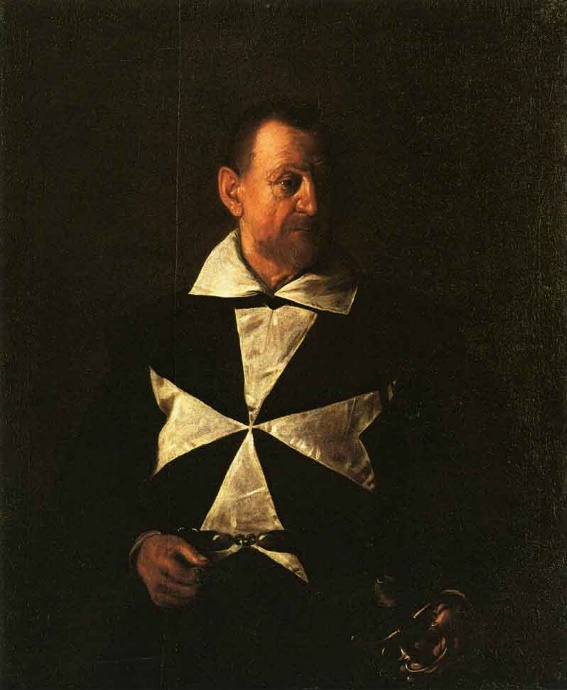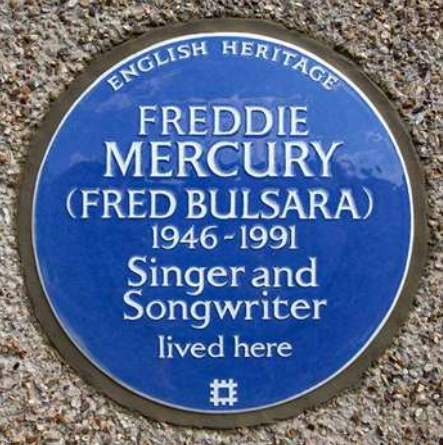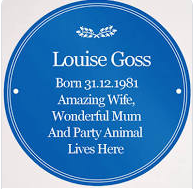Introduction
Our first Friday meeting (16th September) survived an attack of technical gremlins and proved to be a very good opening to the year. A report is given below. The first meeting of the ‘Era of the Crusades’ has also successfully taken place.
Roger Mitchell, our secretary, brings us up to date with the work of the committee, which, as you will see covers a considerable range of issues.
John Sharp has found a connection between our first two events, linking the painter, Caravaggio, with an aspect of the Crusades and Christine Vasey provides an interesting introduction to the Blue Plaques of London.
When paying subscriptions and registering for courses, please note that you need to inform John Sharp, preferably by the application form. You don’t need to post this. Simply add your details and send as an attachment.
Forthcoming Friday Meeting: The Family at Scarisbrick Hall 1807-Present
Friday 28th October at 2:30pm, All Saints Church Hall
This talk will be the second part of a presentation by Mary Ormsby on the occupiers of Scarisbrick Hall. It will start with a brief recap of Charles Scarisbrick before moving on to discuss the works undertaken by Lady Anne Scarisbrick and how the Hall was used by the Casteja family. and later, Charles’ descendants. The presentation will also cover the story post- 1945 when the Hall ceased to be a family home and cover its time both as a Teacher Training College, St Katherine’s, and then as a private school.
There will be a small accompanying exhibition of relevant Scarisbrick Hall photos and related items.
Committee Report: September 2022
Our committee met on Tuesday 27th September. This was the first meeting since the summer break and there was much to catch up on. We began with reports on events. The tours of Scarisbrick Hall had been extremely enjoyable and Mary Ormsby was thanked for all her work, especially the production of the pamphlet, a guidebook of Scarisbrick Hall in miniature. Father Leo’s talk on Caravaggio had got our new programme off to an excellent start, but unfortunately, there had been some technical problems. We are taking steps to prevent any recurrence.
A combination of persistence and patience has enabled our new treasurer, Peter Firth, to update our banking arrangements with HSBC. We now have both online and telephone banking and should be able to reduce our bank charges. All told, a significant achievement. We have reached an agreement about room hire with All Saints for the next two years and hope that current concerns about energy costs will not put this at risk.
John Sharp reported on membership and Course Enrolments. We have 52 (now 63) fully paid-up members with other applications in the pipeline. There are 21 people enrolled on Peter’s course on The Crusades, which is already under way and proving very enjoyable for lecturer and class members alike. Our 2023 courses; Roger on Art and Architecture of the American West and Alan on Uncovering the Mystery in Chemistry; are both recruiting well and are already viable.
We continue to develop contacts with other groups like U3A, Arts Society and Rotary, and maintain links with Continuing Education at Liverpool University. Their 2022 – 3 programme is a mixture of online and on campus courses.
It was agreed that we should purchase a portable sound system for use at All Saints in the large hall
Even though the pandemic seems to be over, we are continuing to use Zoom for most of our committee meetings. It is very convenient and keeps us focused on the task in hand. However, you will be relieved to hear that we still believe that nothing can equal an ‘in person’ meeting and we are planning such a meeting for later in the year to review our present position and to develop an action plan.
Roger Mitchell
Caravaggio – A ‘Cinematic Painter’
Our season of talks started well with a good attendance and an absorbing talk on the art of Caravaggio. Despite his turbulent life and controversial art, Caravaggio was one of the most famous artistic figures of his day. For some centuries after his death, he faded somewhat into the shade, only to return in the modern era as one of the most popular members of the canon of great painters. Father Leo Daley puts this down in part to his ‘cinematism’. His pictures capture dramatically biblical scenes, which seem to be happening at this very moment. The people are those he met in the street, ordinary citizens, not idealised saints.
The meeting started with a near disaster in that the technology for projecting on the back wall failed to work. However, Father Leo Daley enterprisingly used his laptop as a portable display board. It is the case that his descriptions and explanations were so penetrating and well-presented that the attention of the audience was fully engaged throughout. It was a considerable achievement for SUES to have such an account of a great artist by an expert, whose sensitivities to the achievements of his subject were academically satisfying and extremely enjoyable.
John Sharp
The Knights of St. John
Caravaggio always led a rumbustious and often violent life. In 1606, he was involved in a charge of murder in Rome, where he was well established as a leading painter and fled to Naples. It should be remembered that Italy at this time was divided into a number of separate states and the jurisdiction of one did not run in another. He didn’t spend long in Naples and moved to the island of Malta in the same year. In some ways this was a strange decision. At this time the island was under the rule of the Knights of St John and it wasn’t easy to be admitted. However, Caravaggio still had friends in high places and it is probable that influence was exercised on his behalf.
The Knights of St John of Malta were originally the Knights Hospitaller. The order was founded in the Holy Land at the time of the First Crusade and formally recognised in 1113. Their original purpose was to provide physical protection and medical support for pilgrims. They were an example of that curious medieval group, the warrior monks. The most famous of these were the Templars, still the subject of legend and speculation, and the Teutonic Knights who operated in the Baltic area.
A warrior monk was a knight, fully equipped and trained to fight. The Hospitallers were amongst the fiercest and most brutal and were feared by their enemies. But they were also monks, who took the traditional monastic vows and lived by them. Their uniform was a black cloak with an eight-headed cross.
The Knights Hospitaller were an important presence throughout the period of the Christian Kingdoms in the Middle East and they were amongst the last to go when they were forced out of Acre in 1291. They moved first to Cyprus and then to Rhodes. There they were a thorn in the side of the Muslim forces, who launched several campaigns to remove them. This was finally achieved in 1523 and shortly afterwards the Holy Roman Emperor, Charles V, granted them the island of Malta in the Western Mediterranean, believing that they would boost Christian power in the region. This was achieved, but only after the most bitter fighting in which the Order just about held on.

When Caravaggio arrived, the Knights were well established. The Grand Master of the Order, Alof de Wignancourt, was ruler of the island. At first, he seemed to know little about Caravaggio, but when the latter made portraits of leading knights and of Wignancourt himself, he was delighted. In a most unusual step, he made Caravaggio a Knight of Military Obedience, the lowest rank, but one which bestowed on the painter the nobility he had always coveted. He swaggered about the town flaunting his new status and inevitably got into trouble again. The penalty for such disorder was to be thrown in prison, which was what happened to Caravaggio.
The next part of the story would not be out of place in ‘The Count of Monte Cristo’. The prison of Castel San Angelo, Malta, was a formidable structure and, in order to escape, Caravaggio would have to get out of an underground cell carved into the rock, scale the castle ramparts, descend the cliffs to the sea and swim round a promontory to a pick up a boat. Of course, he must have had some inside help, but amazingly he managed to achieve this and escaped to Sicily.
He spent time in Sicily where the authority of the Knights of St John was not accepted. He painted many great masterpieces while on the island. By 1610, he had hopes of a pardon from the Pope and a chance to return to Rome, but became ill on this journey and died before reaching the Holy City.
The Knights continued to rule Malta and the seventeenth century was one of their most successful periods. They improved the infrastructure of the island including its harbour and fortifications and built up an effective navy. They even acquired four islands in the Caribbean. Building projects continued through the eighteenth century, but in later years Malta drifted towards bankruptcy and high taxes made the government of the Knights unpopular. The French Revolution led to a policy of confiscating religious assets and Napoleon visited the island to make it part of his empire. However, to oppose Napoleon, the British came in on the side of the Maltese, only to make it a British colony, which it remained until independence in 1964. However, the order did not disappear. The Knights moved their headquarters to Rome and today, devote themselves to humanitarian enterprises. There are over 13,000 members in different countries and today there are dames as well as knights.
John Sharp
The Blue Plaques of London

For many of us, a trip to London is greatly enhanced by spotting, even if this means crossing a road, the blue circular ceramic plaques that adorn the facades of buildings all over the city. Closer inspection of the inscriptions on the plaques reveals some brief information such as ‘Freddie Mercury: Fred Bulsara (1946 – 1991), singer and songwriter, lived here’. It could be Vincent van Gogh, Florence Nightingale, Charles Dickens or someone we’ve never heard of. There are more than 933 plaques to be discovered in London alone but as you might expect, the number of blue plaque baggers who claim to have found them all is not inconsiderable! According to the official definition, “A blue plaque is a permanent sign installed in a public place in the United Kingdom to commemorate a link between the location and a famous person, event or former building on the site.”
However, these blue plaques are much more than a basic historical record of who did what, where and when and they can turn a simple walk down a street into an adventure! But how do these plaques come to be where they are and who decides who will be commemorated from amongst the massed (and currently gender imbalanced) ranks of science, politics, art, literature, music, architecture, medicine, religion, engineering, exploration, soldering and social reform?
A long-forgotten politician, William Ewart, came up with the idea in 1863. He suggested inscribing the names of famous people on the houses they had occupied in their lifetimes as a commemoration of their achievements and a committee was set up to oversee this process and maintain the plaques in good order. The first plaque, dedicated to Lord Byron, was erected in 1867, perhaps a rather surprising choice, given the rectitude of the Victorian age and the poet’s scandalous reputation, The main criterion for recognition by the original committee and its successors, the current one, English Heritage, apart from being distinguished in your particular field, is that you must have been dead for at least twenty years. This helps to exclude the worst excesses of temporary fame, so there is no guarantee that today’s celebrities, Ant and Dec or Megan Markle, for example, will ever achieve blue plaque status!
Unfortunately, a blue plaque does not necessarily mean that future generations will recognize your name, however remarkable your achievements were in your lifetime, but a bit of research by the casual passer-by can pay dividends. For instance, Mrs Lambert Chambers (1878 – 1960) is hardly a household name, yet she won the ladies’ singles title at Wimbledon seven times between 1903 and 1914 despite her ankle-length skirt, corsets and long-sleeved blouse. Strangely, she was most insistent on the necessity of a warm coat, no matter how hot it might be! She and Serena Williams have won an equal number of Wimbledon singles titles. What a pity we can never see them play together! Has anyone heard of Edward Johnson (1872 – 1944)? Probably not, but millions of Londoners and visitors see his work every day as he was the calligrapher who designed the iconic logo of the London underground. We have already mentioned Lord Byron, but what about his daughter, Ada Lovelace (1815 –1852) who was a brilliant mathematician at a time when maths was considered an unsuitable subject for the delicate female brain. She collaborated with Charles Babbage, the inventor of the computer, (and with a blue plaque of his own) and her contribution to his work makes her one of the world’s first computer programmers.
There are several buildings in London which boast of two blue plaques and the most famous pairing can be found in Brook Street. The first commemorates George Frederick Handel (1685 – 1759) the German composer who spent most of his professional life in London. The second plaque immortalizes Jimi Hendrix (1942 – 1970) considered by many to be the greatest guitarist of all time. It would be rather nice to think that the ghosts of Handel and Hendrix meet up from time to time for a jamming session! A fascinating mixture of rock and Baroque!
You may never qualify for a blue plaque in your own right and they are to be found all over the country, not just in the capital, so living in the Southport area is not necessarily a barrier. However, you can always pop into a souvenir shop and purchase replicas of these blue plaques. Along with models of London buses and Big Ben, they make very popular fridge magnets. If you really feel you need to publicise your achievements to the world at large, all is not lost. You can go online and order your very own iconic personalised heritage plaque for a mere £14.99. Unfortunately, it’s plastic not ceramic, but just think of the enormous respect it would generate in the postman and the Amazon delivery driver and neighbours would undoubtedly be green with envy!

Christine Vasey
Contacts
Chair: Alan Potter
alanspotter@hotmail.com
07713 428670
Secretary: Roger Mitchell
rg.mitchell@btinternet.com
01695 423594 (Texts preferred to calls)
Membership Secretary: Rob Firth
suesmembers74@gmail.com
01704 535914
Forum Editor: Chris Nelson
chris@niddart.co.uk
07960 117719
Facebook: facebook.com/groups/southportues
See our archive for previous editions of the SUES Forum!